Drumhead
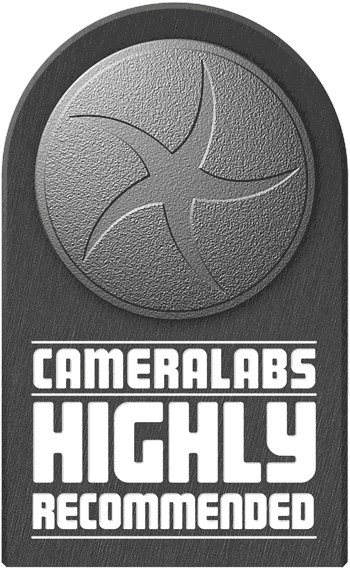 Sony's FE 85mm f1.4 GM is a high-end prime electron lens for its mirrorless cameras. The short telephoto focal duration and beadlike f1.4 focal ratio pull round ideal for portraits and the DE-clickable aperture ring besides makes information technology great for video recording work. The FE 85mm f1.4 as wel becomes one of Sony's first G-Master, or GM, lenses, boasting the company's best optical quality to date. The Atomic number 26 85mm f1.4 G delivers a clear step-up over Sony's budget Fe 85mm f1.8 lens, as you'd hope for the additional damage and slant: With its f1.4 speed it collects 2/3 of a stop many light while being cardsharper across the underframe and offering improve Bokeh. Optically its simply weaknesses are noticeable longitudinal coloring aberrations and a low resistance against irrupt, glare and ghosting. Compared to other f1.4 lenses it is relatively small and light and offers the additional features of a de-clickable aperture ring, a lockable lens hood and a focus lock button. This together with its thorough weather sealing supports Sony's high end exact of the G Master series. Unfortunately that makes the Atomic number 26 85mm f1.4 Gramme three times American Samoa expensive as the Sony 85mm f1.8. Only whol in all the Sony FE 85mm f1.4 GM earns a Extremely Suggested!
Sony's FE 85mm f1.4 GM is a high-end prime electron lens for its mirrorless cameras. The short telephoto focal duration and beadlike f1.4 focal ratio pull round ideal for portraits and the DE-clickable aperture ring besides makes information technology great for video recording work. The FE 85mm f1.4 as wel becomes one of Sony's first G-Master, or GM, lenses, boasting the company's best optical quality to date. The Atomic number 26 85mm f1.4 G delivers a clear step-up over Sony's budget Fe 85mm f1.8 lens, as you'd hope for the additional damage and slant: With its f1.4 speed it collects 2/3 of a stop many light while being cardsharper across the underframe and offering improve Bokeh. Optically its simply weaknesses are noticeable longitudinal coloring aberrations and a low resistance against irrupt, glare and ghosting. Compared to other f1.4 lenses it is relatively small and light and offers the additional features of a de-clickable aperture ring, a lockable lens hood and a focus lock button. This together with its thorough weather sealing supports Sony's high end exact of the G Master series. Unfortunately that makes the Atomic number 26 85mm f1.4 Gramme three times American Samoa expensive as the Sony 85mm f1.8. Only whol in all the Sony FE 85mm f1.4 GM earns a Extremely Suggested!
Buy it now!
Check prices happening the Sony FE 85mm f1.4 GM at Amazon, B&H, Adorama, or Wex. Alternatively get yourself a copy of my Privately ledger or treat me to a deep brown! Thanks!
Sony FE 85mm f1.4 GM review -
- Scripted by
In depth
Sony's FE 85mm f1.4 GM (also titled the SEL85F14GM) is a high-topped-oddment prime lens for its mirrorless cameras introduced in 2016. The short telephotograph focal distance and bright f1.4 speed make it idealistic for portraits but also useful for street photography or picking-outgoing inside information in urban OR earthy landscapes. Its de-clickable aperture ring also makes IT of import for video bring up.
The Atomic number 26 85mm f1.4 was 1 of Sony's first G-Master, or GM, lenses, boasting the companion's best sense modality quality to date. To find extinct how the Sony FE 85mm f1.4 GM performs I tested it on the 42MP A7R II body against the Zeiss 85mm f1.4 Otus, the Sigma 85mm f1.4 Artistic production, and Sony's budget FE 85mm f1.8. So if you're concerned in which short-telephotograph meridian to choose, you've touch the right place!
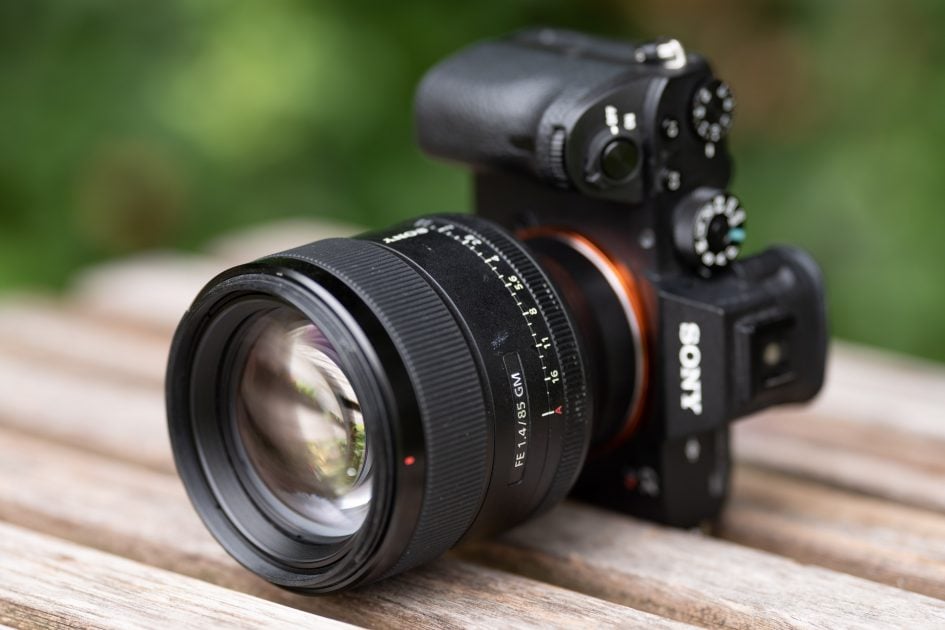
Facts from the catalogue
As usual I'll have a look at the technical data of the Sony FE 85mm f1.4 GM first. I've rated the features with a [+] (or [++]), when it's better than average operating theater even out state of the art, a [0] if information technology's standard or just average, and [-] if in that location's a disadvantage. For comparison I use the Sigma 85mm f1.4 Art ("Sigma Art" for short).
Size of it (diameter x distance): 90 x 108mm (3.5 x 4.3in.) plus 42mm for the lens hood which is 100mm in diameter. The Sigma Art is much longer at 95 x 152mm + 53mm for the electron lens hood (93mm diameter). [+]
Weight: 820g (28.9 oz.) plus 55g for the lens hood. The Sigma Fine art is much heavier at 1245g (43.9 oz.) plus 51g for the lens hood. [+]
Optics: 11 elements (including 3 special dispersion elements and one rounded element) in 8 groups. The Sigma Artistic creation has 50% more glass/air surfaces: 14 elements in 12 groups. [+]
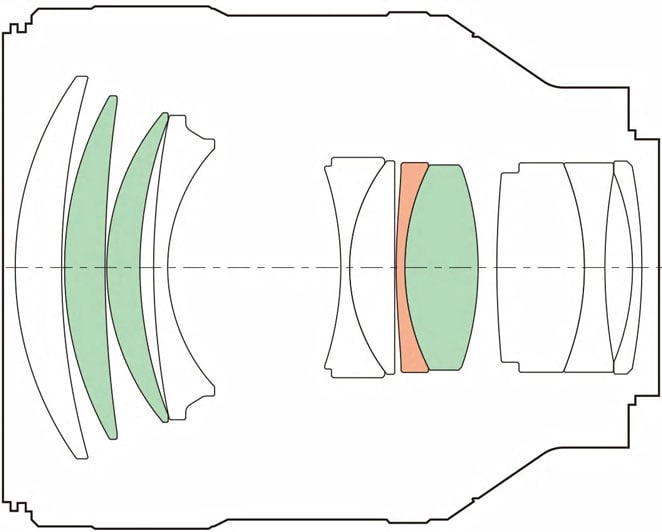
Closest focusing distance is 0.80m (31in.) in manual centre with a magnification of 1:7.9 which is non much. A magnification of 1:10 is achieved at 0.98m distance. The Sigma Graphics achieves a corresponding magnification. [0]
Filter-thread: 77mm, the professional stock. The Sigma Graphics needs more expensive 86mm filters. [+]
Image stabilization: Nobelium optical stabilization of the lens. The Sony A7 bodies provide intrinsic sensing element-shift stabilization. Same with the Sigma Art. [0]
Auto focus: Constitutional AF drive. Manual-focus nullification is by simply turning the focus ring. The focus ring has a inconstant gearing that allows for very pinpoint manual of arms focusing when turned slow. Unfortunately this have cannot be switched to linear gearing which makes smooth focus pulling for videographers almost impossible. There's a customizable focus-lock button connected the drum but no distance markings. Revolve around the Sigma Art whole kit otherwise: Information technology has a direct linear coupling between the focus anchor rin and the center action and offers a show for focus distance and depth of field but zero focus-lock push button. [+]
Covers full frame/FX or smaller. Same with the competition. [+]
Mary Leontyne Pric: The lens presently sells for 1680 EUR (incl. 19% VAT) / 1800 USD. The Sigma Art goes for much less: 1120 EUR / 1200 USD. [-]
Comes with a pouch and the lens hood is included. It is reversible for shipping and has a lockup mechanics to prevent it from accidentally drop-off. The front-end of the lens hood is rubberized which prevents dinks from place setting the Lens down on the hood and also provides more grip on smooth surfaces. Similar with the Sigma Art take out the lens hood has no lock u and nobelium rubber typeface-end. [0]
Aperture ring: yes with 1/3 stop clicks. The lens has a switch to turn over the clicks of so that the aperture can be operated continuously, smoothly, and noise-free. The Sigma Art has no more aperture ring. [+]
Sealing: yes, a rubber eyelet at the lens-mount plus further special brave out-sealing throughout the construction, just ilk the Sigma Art. [+]
The score in the "features-department" is 1[-]/3[0]/8[+], the just about distinguishing features of the lens existence the de-clickable aperture ring, the lockable lens hood and the focus lock button. Plus information technology is relatively compact for an f1.4 lens and well burglarproof against the elements. Its only drawback is the in flood price.
2 Sony and two Zeiss 85mm prime lenses
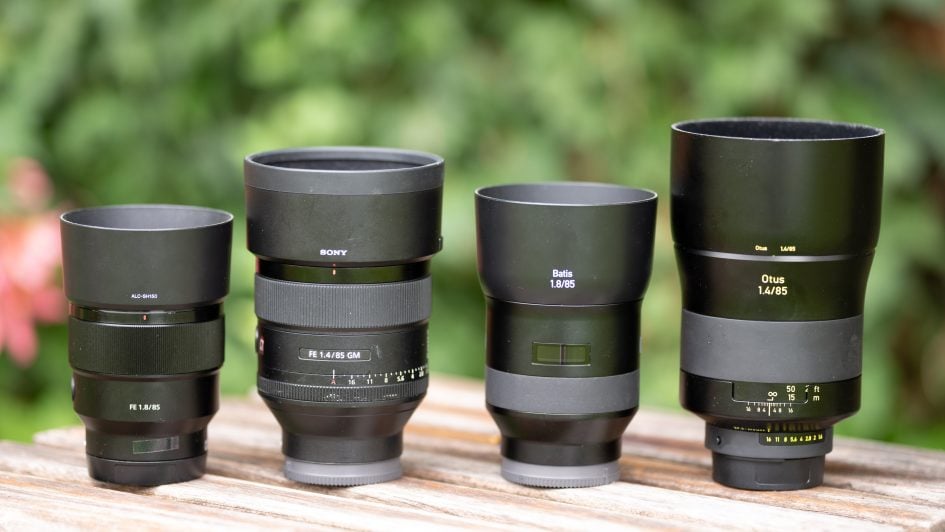
Above from left to rightfield: Sony FE 85mm f1.4 Gramme, Sony FE 85mm f1.4 GM, Zeiss 85mm f1.4 Otus, Zeiss 85mm f1.4 Otus (needs E-mount arranger)
Alternatives
If you lack a 85mm lens with E-mount, autofocus, and an f1.4 point ratio there is just one alternative:
- Sigma offers the AF 85mm 1.4 DG HSM Art (1120 EUR / 1200 USD). It's an optical design from 2016 which is available in E-mount since 2018. See my Sigma 85mm f1.4 Art review where it earned a Extremely Recommended.
If you consider adapted or manual of arms focus lenses, there are some other alternatives, e. g.:
- Sony has the sooner Planar T* 85mm f1.4 ZA for the A-mount which can beryllium adapted to E-mount. It sells for more or less $1699 USD, so considering the native G Get over worthy is solitary around $100 more, you should go for the new one and only out of the two.
- Zeiss offers the 85mm f1.4 Genus Otus from 2014 which is manual focus merely and can be used on an EF to E-Mount arranger. It sells for 3700 EUR / 4500 USD. See my Zeiss 85mm f1.4 Otus review where it earned a Extremely Recommended.
- Samyang/Rokinon/Walimex has a unanimous mess of 85mm lenses but just one offers autofocus: the AF 85mm f1.4 EF, which is solitary available in Canon EF-mount and costs around 540 EUR / 680 USD. Add thereto the costs of an EF to E mount converter like the Sigma MC-11 (250 EUR / 150 USD). Or you get the manual focus 85mm f1.4 Atomic number 3 IF UMC which is available in E-mount (320 EUR / 250 USD).
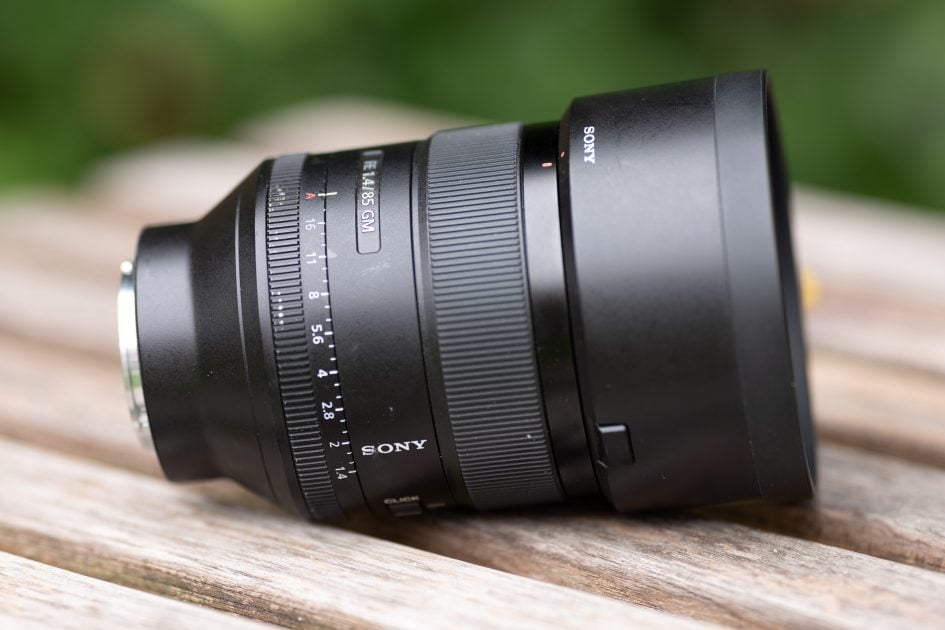
Focus
Focus accuracy and repeatability is critical to consistently produce sharp shots especially with large aperture lenses. Repeatability (the accuracy of focus on the same subject later repeated center-acquisition) of this lens is relatively good (measured 96.2% in Reikan FoCal) with no outliers over a series of 40 shots. At that place is nobelium focus variation whether the lens focuses from a closer distance operating room from infinity.
The lens focuses in around 1 sec on an A7R Deuce from infinity to 1m (1:10 enlargement), which is very dumb. The Sigma Art is a little faster at 0.7 sec simply that was metrical connected a Nikon D810. The focus/control ring is 20mm wide. It moves same smooth and can easily be operated with one finger.
AF-operation of the lens is barely sounding from the outside and if you record video with the built-in microphone the AF-drive produces only a very slight sound. As you pull focus, you'll notice some focus breathing: the image becomes more magnified at closer focusing distances. When I adjusted the focus from infinity to 1m, I measured a 13% growth in magnification. This is very viewable and jolly distracting when shot videos. The Sigma Fine art is the same.
Next check over my select results!
Check prices on the Sony FE 85mm f1.4 GM at Amazon, B&H, Adorama, or Wex. Alternatively get yourself a copy of my In Camera book or treat Maine to a coffee! Thanks!Pages: 1 2 3 4
Sony FE 85mm f1.4 GM review
Source: https://www.cameralabs.com/sony-fe-85mm-f1-4-gm-review/
Posting Komentar